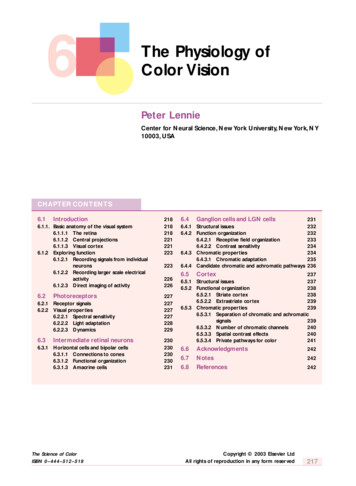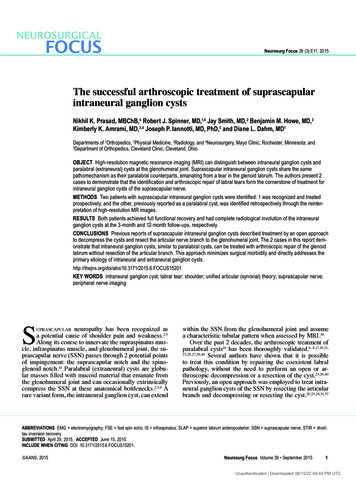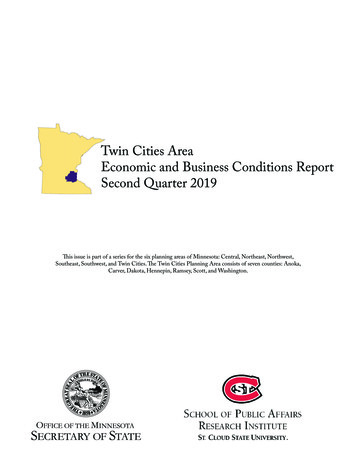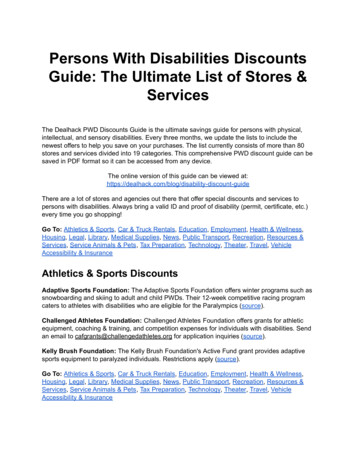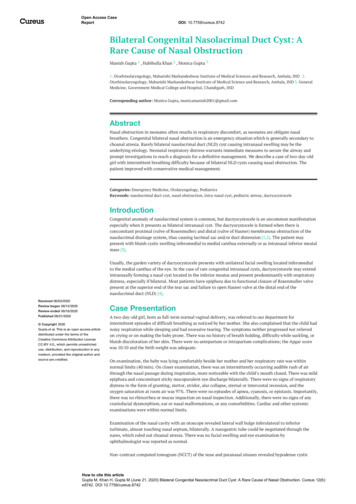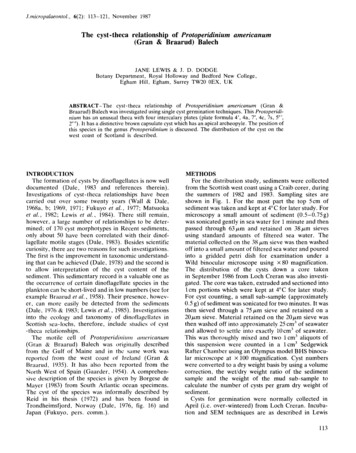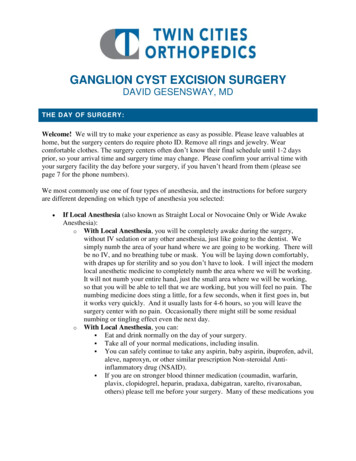
Transcription
GANGLION CYST EXCISION SURGERYDAVID GESENSWAY, MDTHE DAY OF SURGERY:Welcome! We will try to make your experience as easy as possible. Please leave valuables athome, but the surgery centers do require photo ID. Remove all rings and jewelry. Wearcomfortable clothes. The surgery centers often don’t know their final schedule until 1-2 daysprior, so your arrival time and surgery time may change. Please confirm your arrival time withyour surgery facility the day before your surgery, if you haven’t heard from them (please seepage 7 for the phone numbers).We most commonly use one of four types of anesthesia, and the instructions for before surgeryare different depending on which type of anesthesia you selected: If Local Anesthesia (also known as Straight Local or Novocaine Only or Wide AwakeAnesthesia):o With Local Anesthesia, you will be completely awake during the surgery,without IV sedation or any other anesthesia, just like going to the dentist. Wesimply numb the area of your hand where we are going to be working. There willbe no IV, and no breathing tube or mask. You will be laying down comfortably,with drapes up for sterility and so you don’t have to look. I will inject the modernlocal anesthetic medicine to completely numb the area where we will be working.It will not numb your entire hand, just the small area where we will be working,so that you will be able to tell that we are working, but you will feel no pain. Thenumbing medicine does sting a little, for a few seconds, when it first goes in, butit works very quickly. And it usually lasts for 4-6 hours, so you will leave thesurgery center with no pain. Occasionally there might still be some residualnumbing or tingling effect even the next day.o With Local Anesthesia, you can: Eat and drink normally on the day of your surgery. Take all of your normal medications, including insulin. You can safely continue to take any aspirin, baby aspirin, ibuprofen, advil,aleve, naproxyn, or other similar prescription Non-steroidal Antiinflammatory drug (NSAID). If you are on stronger blood thinner medication (coumadin, warfarin,plavix, clopidogrel, heparin, pradaxa, dabigatran, xarelto, rivaroxaban,others) please tell me before your surgery. Many of these medications you
can continue taking normally. Sometimes we will have you not takewarfarin/Coumadin for 2-3 days before surgery depending on your bloodthinner level (INR) and why you are taking the medication. If you take narcotic medication every day you can continue it normally. You can drive yourself to and from the surgery center, but not if you arehaving both hands operated on the same day. Your exact surgery time is, unfortunately, somewhat unpredictable, soplease do not schedule or plan for work or meetings on the same day afteryour surgery. If IV Sedation (also known as Conscious Sedation or Twilight Anesthesia):o With IV Sedation anesthesia, you will get an IV placed at the surgery center,and you will be given medication in the operating room by the anesthesia team tomake you sleepy. Generally they do not put you completely asleep, but rather youwill drift off to sleep and can be completely unaware of the surgery, if you want.You can discuss how sleepy or unaware you want to be with your anesthesia teamin the pre-op area before surgery. Once you are sedated, I will completely numbthe surgery site with the local anesthetic, so you will feel nothing of the injectionor surgery. You will start to wake up when we are finishing with the surgery andputting on the bandages, and the sedation medicine usually wears off quitequickly. You will have no pain, and the numbing medication usually lasts about4-6 hours, so you will leave the surgery center with no pain. Occasionally theremight still be some residual numbing or tingling effect even the next day. If Arm Block Anesthesia (also known as a regional block, axillary block, orsupraclavicular block):o With Arm Block Anesthesia, you will get an IV and IV sedation, as describedabove, and then the anesthesiologist will make your entire upper limb numb byblocking the nerves near your arm pit or collar bone. The anesthesiologist willdiscuss all aspects of your anesthesia with you in consultation, in the pre-op roombefore surgery. After the block is placed, you will be given more medication inthe operating room by the anesthesia team to make you sleepy. Generally they donot put you completely asleep, but rather you will drift off to sleep and can becompletely unaware of the surgery, if you want. You can discuss how sleepy orunaware you want to be with your anesthesia team in the pre-op area beforesurgery. If the block is not making your arm fully numb then you might go tosleep as well, with a general anesthetic. You may start to wake up when we arefinishing with the surgery and putting on the bandages, and the sedation medicineusually wears off quite quickly. You will generally have no pain, and thenumbing medication usually lasts about 8 or more hours, so you will leave thesurgery center with no pain. How long the block lasts is very variable, but theanesthesia team will give you an estimate. Occasionally there might still be someresidual numbing or tingling effect even the next day. You need a sling to protectyour arm until the block wears off. If General Anesthesia:o With General Anesthesia, you will get an IV and then given medication so thatyou will be completely asleep during the surgery. Once you are asleep, I willcompletely numb the surgery site with the local anesthetic, so you will generallywake up with no pain. The numbing medication usually lasts about 4-6 hours, so
you will leave the surgery center with no pain. Occasionally there might still besome residual numbing or tingling effect even the next day.With IV Sedation OR Arm Block Anesthesia OR General Anesthesia, you will needto:o Have nothing to eat or drink for at least 8 hours prior to your surgery.o You can and should take your usual important medications with a sip of water onthe day of your surgery.o If there is ANY chance that you are pregnant please do a pregnancy test the daybefore surgery and notify the surgery center.o If you have Type 1 insulin dependent diabetes, please let me know and consultpre-operatively with your endocrinologist or family doctor. The plan generallyincludes taking all or half of your lantus or long-acting insulin the night beforesurgery, or continuing your normal basal rate on your pump overnight. Thendepending on your morning blood sugar levels, either continue or lessen yourbasal rate so you don’t get low. You may need to check your glucose more oftenthan normal. Even without eating before surgery your blood sugar can rise due tothe normal stress of surgery. You can continue wearing your pump during theprocedure. Bring your meter, etc to the surgery center. If you do get low, ofcourse take something, preferably glucose tabs or hard candy, or juice/coke ifneeded.o You will need a driver to take you home, and a “responsible adult” to go over thepost-op instructions with you at the surgery center, and stay with you that dayafter surgery.o You should not return to work or the office or attend meetings on the same day ofyour surgery.DURING GANGLION CYST EXCISION SURGERY – WHAT IS DONE:The cyst is removed, including its root, which is the small tube connecting the cyst to thejoint or tendon where it originated. We leave the resulting hole in the lining of the joint open, tolessen the chance of making a new cyst. The lining of the joint will heal over the next month,which is why it the joint can be stiff and sore for a month or sometimes more after surgery.AFTER CARPAL TUNNEL SURGERY: Bandage/splint/surgical dressing careo Please keep your hand elevated as much and as often as possible for 2-4 days aftersurgery. This helps reduce swelling, and your hand may throb and feel worse if itis hanging down. This is very important!o In bed at night you can easily keep your hand comfortably elevated by wrapping athin pillow around your forearm, and secure it with tape or an ace wrap or a safetypin, then place your elbow on another pillow. The wrapped pillow will hold yourarm upright for you, with your elbow bent at a right angle.
o Please keep your surgical bandage on and clean and dry until your post-operativeappointment.o You may shower/bath, but keep the bandage dry. You can use a plastic bag tapedup at the end, saran wrap or press-n-seal.o If you had a full arm block, you need a sling to protect your arm until the blockwears off, but still try to elevate it as much as possible.Hand Therapy Exerciseso I want you to move any and all unsplinted digits and joints as much and as oftenas you are able. Speed doesn’t help, but try to get the full excursion (range ofmotion), moving them as far as they can go. You can use your other hand to helpthem. Also, please move your shoulder through its full range of motion, often.We don’t want anything to get stiff.Hand Useo It is OK to use your hand fully as much as you are able. Typing, writing, eating,and dressing are all Ok to do. You will not be able to do any strong gripping orgrasping, pulling or pushing, or operating of power tools. You can’t damage orharm anything by using your fingers and hand. But it might hurt if you overuse it,so just go by how it feels.Pain Management Expectationso You will likely be pain free when you leave the surgery center, and the numbingeffect of the local anesthesia or arm block will likely last 4-6 hours but is variable.Occasionally there might still be some numbing/tingling effect from the blockeven the next morning. I recommend starting the pain medicine before thelidocaine local anesthesia wears off. The anti-inflammatory medications workwell for this condition.Pain Medicationso There are three types of pain pills. All three types can be taken together, and at thesame time. Their pain-relieving effects are additive. Tylenol (acetaminophen) Non-narcotic, safe Inexpensive, comes in generic Regular strength is 325mg Extra-strength is 500mg The dose is 1000mg 3-4 times per day. Many over the counter pain and cold preparations containacetaminophen. It is also a fever reducer. Non-steroidal Anti-inflammatory drugs (NSAIDs) Ibuprofen (Advil)o Sold over the counter as 200mg pillso Inexpensive, comes in genericso Can take 1-3 pills every 6 hours or up to four times per day(lasts 6 hours)o Do not take if you are already taking a prescription NSAID(there are many) as there is just extra risk and no extra painrelief.o Do not take both ibuprofen and naproxen at the same time Naproxen (Aleve)
oooo Narcotics Require a doctor’s written prescription and generally cannot berefilled over a weekend or holiday. Fairly safe for short-term use. All types can become habit forming and addicting. You can build up a tolerance to narcotics over time, meaning ifyou continue to take them long-term it takes a higher dose toproduce the same effect (like alcohol). They affect different people differently (like alcohol) All are constipating. Best to take a stool softener (colace) and abulk agent (metamucil, fiber, prunes) if you are susceptible toconstipation or are taking these medications beyond a week. All can cause some itching. All can cause some nausea. All are sedatives that cause varying degrees of sleepiness that caninterfere with driving and decision making, and can causeunsteadiness and lightheadedness. Best not combine narcotics with alcohol or other narcotics Are often sold in a combination pill with acetaminophen (Tylenol). Commonly used narcotic medications are:o Tramadol (Ultram) 1 pill every 6 hours as needed Generally the lightest and best tolerated with the leastunpleasant side-effectso Hydrocodone with acetaminophen (Vicodin, Norco,Lortab) 1-2 pills every 4-6 hours as needed This medication requires the actual written prescriptionfor any refill and cannot be called in.o Oxycodone with acetaminophen (Percocet, roxicet) 1-2 pills every 4-6 hours as needed This medication requires the actual written prescriptionfor any refill and cannot be called in.Iceo Sold over the counter as 220mg pillsInexpensive, comes in genericsCan take 1-2 pills twice a day (lasts 12 hours)Do not take if you are already taking a prescription NSAID(there are many) as there is just extra risk and no extra painrelief.While ice is generally very good for pain and swelling for the first 48 hours afterany injury or surgery, it is not too effective to ice through your dressing or splintor cast. Some people report that it feels good to ice the skin just above theirdressing/splint/cast and that is OK, but not necessary.Exercise (fitness)
oIt is OK and beneficial to remain active after your surgery. Walking is good, andyou can elevate your hand while walking.o For 4 weeks after surgery, it is OK to continue any kind of aerobic fitness routine,but you will not be able to do strenuous activities with your hand/wrist. It isgenerally OK to do any exercise if you are able to do it comfortably, letting painbe your guide. If the cyst was on the back of your wrist, it can take 1-4 months forpain-free push-up type activities. Drivingo It is OK to drive a car if you can do it safely with your other hand and you are noton narcotic medication. Most people are able to drive a manual transmission.You cannot drive a motorcycle or snowmobile for 4-6 weeks. Worko Most people are off work for a few days or a week, and then on light, restrictedduty work restrictions for the operated arm for about 4 weeks post-op. People aredifferent, and their job demands are different, so your exact return to work planwill be individualized for you, and should be discussed ahead of time. Almosteveryone can get back to doing their usual job eventually, without restrictions.Permanent restrictions are very unusual. Diet/food/eatingo You can resume your usual diet, and there is no need for anything special or forany supplements. Smoking, or the use of any nicotine-containing product, canslow and delay wound healing. Problemso Please call us if you have: Fever over 101.5 for more than a day Foul smelling drainage from the dressing or wound Excessive bleeding Uncontrolled paino Please seek ER evaluation or treatment if you have: Persistent vomiting Inability to void (urinate) for more than 8-10 hours after surgery Shortness of breath or chest pain Severe allergic reactionYOUR FIRST POST- OPERATIVE VISIT:Your first visit back after surgery will be with the Hand Therapist or me, 3-6 days after surgery.The bandage will be removed, and you will be fit with a removable splint and instructed onexercises. You will work on getting back all of your joint motion, and the swelling goes downwith elevation and moving the fingers. The exercises are done slowly. It is OK to use your handas you are able, but you will be using the limb lightly for about 4 weeks. We often leave thesutures in for another week to keep the scar from widening, depending on where your incisionwas. It is OK to get your incision wet after the bandages are removed, but no soaking in a bathor hot-tub or pool until the sutures are out. Updated work slips will be issued at each and everyclinic visit with me, as needed.
Charges for all post-op doctor visits within 90 days of surgery are generally included withthe surgery “global fee”. Charges for X-rays, splints, casts, supplies, medications and HandTherapy visits are often not included in the surgery “global fee”. For questions about your billfrom Twin Cities Orthopedics, please contact our Customer Service Department at 952-5125625.QUESTIONS?: For questions about your medical condition or surgery please contact me or Julie (myHand Therapist) through our Care Coordinator Sarah at 952-456-7084.For questions about scheduling, insurance, paperwork, or work slips please call Sarah,our Care Coordinator, at 952-456-7084.For prescription refills please call Sarah at 952-456-7084.For questions about surgery arrival time or other day-of-surgery questions please contactyour Surgery Center location directly.o Crosstown Surgery Center: 952-456-7333o WestHealth Surgery Center: 763-577-7240o Abbott Northwestern Hospital: 612-863-3138For after-hours medical urgent questions please reach the on-call Orthopedic Surgeon at952-920-0970.Our Walk-In Access Clinic, TCO Orthopedic Urgent Care, is open every day at the Edinalocation from 8:00 am – 8:00 pm, for urgent problems with your cast or other urgentpost-op problems. It is also open from 8am – 8pm on Saturday and Sunday. For any ofthe many other metro locations and hours for our Urgent Care centers, please visit ourwebsite www.tcomn.com.For billing questions, please call TCO Customer Service at 952-512-5625.For questions about your surgery center bill, co-pays or out-of-pocket costs please callyour specific surgery center directly (above).For questions about your anesthesia bill, please call your anesthesia provided directly.THANK YOU!
course take something, preferably glucose tabs or hard candy, or juice/coke if needed. o You will need a driver to take you home, and a "responsible adult" to go over the post-op instructions with you at the surgery center, and stay with you that day after surgery. o You should not return to work or the office or attend meetings on the same .


